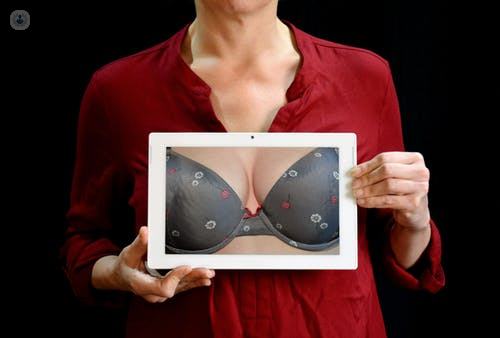Breast reconstruction after a mastectomy
Written in association with:Following a mastectomy, many women will opt to have breast reconstruction. There are various methods of reconstructing the breast, with the two main procedures being implant reconstruction and flap reconstruction. Miss Christina Choy talks to us about the ins and outs of breast reconstruction surgery and if there are any alternatives.

Reconstruction put simply is rebuilding the breast and reconstructing its shape. It can be done at the same time as a mastectomy, however, it depends on the person and how aggressive the cancer is. Some people will wait a few months to a few years to undergo reconstruction due to personal reasons or other therapies which may take priority. Some are concerned about radiotherapy which may have an adverse cosmetic outcome for immediate breast reconstruction. Immediate reconstruction, however, is the preferred option in general and easier to achieve a natural looking breast.
What does reconstructive surgery involve?
Depending on the type of reconstructive surgery chosen, the surgery will vary. Each method has its own pros and cons.
Implant reconstruction
Implant reconstruction involves using implants, which are internal breast prostheses to rebuild the breast mount.
Different types of implants can be used, such as silicone gel implants or saline implants. Implants can be round or teardrop in shape, their surface can be textured or smooth. Implants are a good option for women who have smaller sized breasts or don’t have extra fat to transfer from other parts of their bodies, as is the case with flap reconstruction.
Flap reconstruction
Flap or autologous reconstruction involves removing fat from another part of the body and transferring it to the breast to achieve a natural looking breast. These can be a pedicle flap or free flap.
Free flap requires joining the blood vessels of the flap using fine techniques. DIEP flap is gaining popularity, which involves transferring fat, skin and its own blood vessels from the tummy to rebuild the chest. Blood vessels in the flap are reattached to blood vessels in the chest using microsurgery. Other free flaps could be from the (gluteus muscle) buttock and thighs.
Most autologous reconstruction such as DIEP flap has enough volume for reconstruction and does not require an additional implant. It is more natural, there is no need for a future implant and it does not bring implant-associated complications such as potential ALCL (acute large cell lymphoma), which is rare but has received a lot of media attention. On the other hand, flap surgery is more difficult, more time consuming and has a longer recovery period. The free flap also has its own potential complications.
Pedicle flap has its own blood supply attached and is considered more robust, e.g. the latissimus dorsi (LD) flap. However, the LD muscle is thin and most of the time it will need an underlying implant to make up the required volume. This is getting less popular nowadays. Other flaps such as TRAM flap reconstruction involve removing tissue and muscle from your lower abdomen and transferring it to the breast tissue to achieve a natural looking breast.
Fat transfer or lipo-remodelling can compliment breast reconstruction to improve symmetry or smoothness. In some cases, multiple sessions of fat transfer can build up the required volume for the whole breast reconstruction.
Nipple reconstruction
If the nipples needed removing during the mastectomy, these can also be reconstructed using local flaps from the reconstructed breast and folding them to make a nipple. Another way is to take part of the contralateral nipple and graft it onto the breast that has undergone the mastectomy. Micropigmentation (tattooing) will add the matching colour at a later stage. The nipple can also be drawn or tattooed using an optical illusion effect to look like a real nipple (3D tattooing).
How do you achieve symmetry when performing reconstruction surgery?
When undergoing reconstruction surgery, you have to be realistic and aware that reconstructed breasts will never be the same as natural breasts. Often further surgeries are required to get better symmetry such as reducing, lifting or augmenting the other side to match. A well done reconstructed breast may look natural, but the sensation will be different, with patients reporting a feeling of numbness. Natural breasts droop with age, but implants will never droop. The main aim of achieving even looking breasts is to create breasts that look reasonably symmetrical and good in a bra.
What is the recovery time following reconstruction surgery?
Recovery time following breast reconstruction depends on the individual patient and the type of reconstructive surgery.
Recovery from implant reconstruction
Recovery from implant reconstruction is usually quicker and takes between six to eight weeks. Early mobilisation and walking are advised and a hospital stay of about two nights before removing drains and for monitoring. Women can manage personal care immediately after surgery.
Recovery from free flap surgery
Recovery from free flap surgery takes longer, about two to three months, as this operation requires the healing of other body parts as well as the breast. It may be difficult to lie in a v shape and to move as normal at the beginning. Physiotherapy will be required. The hospital stay is about five days and the patient will be given a guide to help with recovery. A check-up should be scheduled a week after the surgery, but on a weekly basis if a seroma is present, especially for implant-based reconstruction.
As with every surgery, there is the risk of complications that can interrupt the road to recovery, such as hematoma from bleeding or infection that may require intense antibiotics or even implant removal. It is also worth noting that further surgery will be required in the future for finer tuning or if the other breast doesn’t match the size and volume of the reconstructed breast.
Alternatives to breast reconstruction
To achieve natural-looking breasts after a mastectomy, the only option other than reconstructive surgery is the use of an external prosthesis to be used in a bra. These can differ in shape, size and colour and are a cheaper alternative. As this does not involve reconstructive surgery, this avoids the complications of surgical reconstruction. However, without a bra and external prosthesis, the breast will be flat. Women who want to have natural looking breasts again, even without clothes will opt to have reconstructive surgery done.
Would you like more information regarding breast reconstruction? Then visit Miss Christina Choy’s Top Doctor’s profile for any enquiries.


